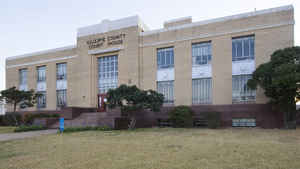Texas Counties
Texas is divided into two hundred and fifty-four counties, more than any other state. Texas was originally divided into municipalities, a unit of local government under Spanish and Mexican rule. When the Republic of Texas gained its independence in 1836, there were 23 municipalities, which became the original Texas counties. Many of these would later be divided into new counties. The most recent county to be created was Kenedy County in 1921. The most recent county to be organized was Loving County in 1931Gillespie County, Texas
Gillespie County Education, Geography, and History

Gillespie County is a county located on the Edwards Plateau in the state of Texas. Based on the 2010 census, its population was 24,837. The county
seat is Fredericksburg. It is located in the heart of the Texas Hill Country. Gillespie is named for Robert Addison Gillespie, a soldier in the
Mexican-American War.
On December 15, 1847, a petition was submitted to create Gillespie County. In 1848, the legislature formed Gillespie County from Bexar and Travis
Counties. While the signers were overwhelmingly German immigrants, names also on the petition were Castillo, Pena, Munos, and a handful of nonGerman
Anglo names.
Gillespie County comprises the Fredericksburg, TX Micropolitan Statistical Area.
Etymology - Origin of Gillespie County Name
Robert Addison Gillespie, a merchant and soldier in the Mexican-American War
Demographics:
County QuickFacts: CensusBureau Quick Facts
Gillespie County History
Early native inhabitants were the Tonkawa, Comanche, Kiowa, and Lipan Apache peoples. In 1842, the Adelsverein
organized in Germany to promote emigration to Texas. The Fisher-Miller Land Grant set aside three million acres (12,000 km2) to settle 600
families and single men of German, Dutch, Swiss, Danish, Swedish, and Norwegian ancestry in Texas. Henry Francis Fisher sold his interest in the
land grant to the Adelsverein in 1844. Prince Carl of Solms-Braunfels secured the title to 1,265 acres (5.12 km2) of the Veramendi grant the next
year, including the Comal Springs and River, for the Adelsverein. Thousands of German immigrants were stranded at port of disembarkation, Indianola,
on Matagorda Bay. With no food or shelters, living in holes dug into the ground, an estimated 50% die from disease or starvation. The living began
to walk to their destinations hundreds of miles away. About 200 German colonists, who walked from Indianola, founded the town of New Braunfels at
the crossing of the San Antonio-Nacodoches Road on the Guadalupe River. John O. Meusebach arrived in Galveston. The first wagon train of 120
settlers arrived from New Braunfels. Surveyor Hermann Wilke laid out the town. Meusebach named it Fredericksburg, in honor of Prince Frederick of
Prussia.[
In 1847, the Meusebach-Comanche Treaty was made. About 150 settlers petitioned the Texas Legislature to establish a new county, suggested names "Pierdenales"
or "Germania". The Vereins Kirche became the first public building in Fredericksburg. It served as a nondenominational church, school, town hall,
and fort. Locals referred to it as 'the Coffee Mill Church' for its shape. Wilhelm Victor Keidel was the county's first doctor. Mormon leader Lyman
Wight founded the community of Zodiac.
The Legislature formed Gillespie County from Bexar and Travis Counties in 1848. They named it after Tennessee transplant Capt. Robert Addison
Gillespie, a hero of the 1846 Battle of Monterrey in the Mexican-American War. Fredericksburg became the county seat.
Handbook of Texas Online
The first known residents of Gillespie County were the Tonkawa Indians. By the nineteenth century, Comanches and
Kiowas had also moved into the area. The future county was first settled by Europeans in 1846, when John O.
Meusebach led a group of 120 Germans
sponsored by the Adelsverein to the site of Fredericksburg, which became one in
a series of German communities between the Texas coast and the Fisher-Miller Land Grant,
originally the immigrants' ultimate destination. Fredericksburg and the surrounding rural areas grew quickly, and on
December 15, 1847, 150 settlers petitioned the Texas legislature to establish a new county, which they suggested be
named either "Pierdenales" or Germania. The legislature formally marked the new county off from Bexar and Travis
counties on February 23, 1848, named it after Capt. Robert A. Gillespie, a hero
of the recent Mexican War, and made Fredericksburg the county seat. Gillespie
County originally included areas that today are parts of Blanco, Burnet, Llano, and Mason counties. It underwent the
first of five boundary changes in 1858, when the legislature formed Mason and Blanco counties, changed the Llano
County boundary and established the present northern and eastern boundaries of Gillespie County. The last change
came in 1883, when the county's boundaries were redefined and its present limits set. More at
Martin Donell Kohout, "GILLESPIE COUNTY," Handbook of Texas Online (http://www.tshaonline.org/handbook/online/articles/hcg04),
accessed January 23, 2016. Uploaded on June 15, 2010. Published by the Texas State Historical Association.
Geography: Land and Water
As reported by the Census Bureau, the county has a total area of 1,061 square miles (2,749 km2), virtually all
of which is land.
Neighboring Counties
Bordering counties are as follows:
- Mason County - northwest
- Llano County - northeast
- Blanco County - east
- Kendall County - south
- Kerr County - southwest
- Kimble County - west
Education







